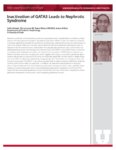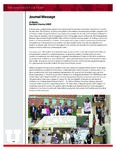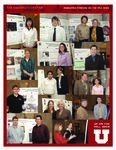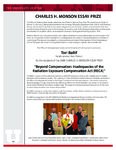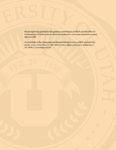Contents | 8 of 12
Research Posters on the Hill of undergraduate research abstracts vol 8
| Title | University of Utah Undergraduate Research Abstracts, Volume 8, Spring 2008 |
| OCR Text | Show A Message from President Young.....2 A Message from John Francis.....3 A Message from Steve Roens.....4 Undergraduate Abstracts.....5 A Message from Jill Baeder.....110 Research Posters on the Hill.....111 Charles H. Monson Prize Winner.....142 Honors Program.....146 Alphabetical Index.....165 |
| Subject | University of Utah -- Students -- Periodicals |
| Publisher | J. Willard Marriott Library, University of Utah |
| Date | 2008 |
| Type | Text |
| Format | application/pdf |
| Language | eng |
| Rights Management | Digital image © copyright 2009, University of Utah. All rights reserved. |
| Holding Institution | Office of Undergraduate Studies Sill Center 195 S. Central Campus Dr. Salt Lake City, UT 84112 Office of Undergraduate Studies Sill Center 195 S. Central Campus Dr. Salt Lake City, UT 84112 |
| Source Material | Bound journal |
| Source Physical Dimensions | 14 cm x 21 cm |
| ARK | ark:/87278/s6p26z6z |
| Temporal Coverage | Spring 2008 |
| Setname | uu_urop |
| ID | 417406 |
| Reference URL | https://collections.lib.utah.edu/ark:/87278/s6p26z6z |
Page Metadata
| Title | Research Posters on the Hill of undergraduate research abstracts vol 8 |
| OCR Text | Show THE UNIVERSITY OF UTAH RESEARCH POSTERS ON THE HILL 2008 TM UP ON THE HILL 2008 RESEARCH POSTERS ON THE HILL SPRING 2008 TM UP ON THE HILL 2008 THE UNIVERSITY OF UTAH RESEARCH POSTERS ON THE HILL 2008 TM UP ON THE HILL 2008 114 Geometry of Mobius Transformation Muhammad Adeel ( Dan Margalit) Department of Mathematics University of Utah The goal of the research project Geometry of Möbius Transformations was to explore the theory of groups generated by Möbius transformations of Riemann sphere. Along with mathematical explo-ration, investigation was done with computer as well. Computer exploration were carried using programming language C++, though images are generated using Metapost, a latex based tool. I will explain the generation of a double spiral which is a stereographic projection of the spiral from Riemann Sphere to complex extended plane. For this projection, we conjugate the Möbius transformation with some other Möbius transformation such that conjugate transformation maps each fixed point to some fixed point. In addition, some other generated images will be shown to explain its behavior on geometrical objects such as square. This can be extended to a fractals- like image generated by a free group of Schottky circles. RESEARCH POSTERS ON THE HILL SPRING 2008 115 Inactivation of GATA3 Leads to Nephrotic Syndrome Nephrotic syndrome is characterized by proteinuria, hypoalbuminemia, hyperlipidemia and edema and represents a clinically significant problem in the pediatric population. While it is clear that nephrotic syndrome is primarily a glomerular disorder, the mechanisms remain poorly understood; however, since the majority of cases occur during childhood, it has been hypothesized that abnormal glomerular development plays an important role. Transcription factors, small proteins that regulate gene expression, play a central role in all developmental processes. Our laboratory has recently shown that GATA3, a transcription factor, is critical for normal glomerular development and function. Furthermore, inactivation of GATA3 leads to nephrotic syndrome in newborn mice, but not adult mice, which suggests that it plays a critical role in glomerular development. We are able to inactivate GATA3 using the temporally? regulatable Cre? loxP system to delete floxed exon 4 of GATA3 in embryos by administring a single gavage dose of tamoxifen to the pregnant dams. We found that inactiva-tion of GATA3 in 7? day old mouse pups leads to edema ( ascities) and death by week four and five, while it had no effect on adult mice. In addition, we observed severe proteinuria in the pups? about 1? 2 Ìg of pro-tein per Ìl of urine. Furthermore, glomerular histology showed no open capillaries, hypercellularity, increased mesangial matrix, and underdeveloped glomerular compared to control mice. This study is the first to eluci-date glomerular function mechanisms and shows that GATA3 is required for norma lglomerular develop-ment and may play a role in regulating glomerular function. THE UNIVERSITY OF UTAH RESEARCH POSTERS ON THE HILL 2008 Safia Ahmed, Olivia Lucero ( Raoul Nelson, Lance Miller) Department of Pediatric Nephrology University of Utah School of Medicine 116 Embryonic Development in Drosophila as a Model for Human Disease Zinovii Abolnik, Truston Bodine ( Anthea Letsou) Department of Human Genetics University of Utah Neural tube defects ( such as spina bifida) result from a failure to complete neural groove closure and affect approximately 40,000 neonates in the United States per year. A good model system for this problem is dorsal closure in the fruit fly Drosophila melanogaster. Studying the simpler dorsal closure system in Drosophila will facilitate an understanding of analogous molecular mechanisms in vertebrates, i. e. those affecting neurulation. This model system can also provide other useful information for understanding human developmental events, including palate closure and wound healing. Dorsal closure is a vital developmental event in Drosophila melanogaster embryos. Dorsal closure occurs midway through embryogenesis; during this process, the lateral epithelial sheets elongate over the embry-onic amnioserosa, ultimately meeting and fusing along the dorsal midline. One of the signaling pathways that is known to play a major role in dorsal closure is the JNK ( Jun N- terminal kinase) cascade. One of the important roles of the JNK signaling cascade is the transcriptional activation of Dpp ( decapentaplegic) in leading edge cells. The raw and mmy genes have been found to be antagonists to the JNK cascade that lim-its Dpp expression to the leading edge cells. Mutations in these genes result in over- expression of Dpp, and in dorsal- open phenotypes which vary in severity depending on the mutation. The hep gene is involved in the regulation of the JNK cascade as an activator. Mutations in the hep gene result in an opposite pheno-type ( no Dpp expression) than that of both raw and mmy mutants. With these opposing phenotypes two epistasis experiments are being performed by creating mmy hep and raw hep double mutant flies. Whether mmy and raw function up or downstream of hep in the JNK signaling cascade can then be determined by looking at the phenotypes expressed in these double mutant lines. The JNK cascade triggers the secretion of Dpp from leading edge cells, which activates signaling in adjacent cells to induce their elongation. Punt is a Dpp receptor in the Dpp signaling cascade; flies lacking put ( the corresponding gene for Punt) result in a dorsal- open phenotype. The keph gene is believed to interact with put. Flies with mutations in keph are homozygous lethal. Deletion mapping is being done locate keph', for the eventual purpose of cloning the gene. Once the gene has been cloned, it can be further investigated as to how it interacts with put. Study on how these two signaling cascades function in dorsal closure in Drosophila can result in a better understanding of analogous molecular systems in vertebrates, and facilitate definition of those mechanisms. RESEARCH POSTERS ON THE HILL SPRING 2008 117 The Possibilites are Endless: A Typology of Microarchaeological Finding The field of archaeology offers little opportunity to understand remains in a primary context. It is far more common to find things in a secondary or tertiary con-text. Most often one finds large, or macro, artifacts in their places of abandonment, not their places of every-day use. In order to account for the problems of arti-facts in primary context and to discover the actual use of space in a particular area, we must consider the microartifact. A microartifact is, like its name indicates, a very small artifact ( under 1 cm in size). Such artifacts are not usually found through visual sampling because of their small size and the fact that they are difficult to see during traditional excavation. Since microartifacts are usually trampled into earthen surfaces rather than being discarded in refuse heaps, microartifacts are an excellent source forstudying the use of space. Through the study of microartifacts from primary contexts, we can discover and begin tounderstand the activities that took place in particular rooms or work areas. I pro-pose the development of a typology of everything that one might find when doing microarchaeological analysis. Indeed, the more we know about what we find, the better our analysis and interpretation will be. There are many different types of pottery, many different types of material used in making pottery, many different types of stone used in formation of lithics, many different types of shell, and many different species of animal bone that are burned or unburned. In some cases, it is impossible to tell suchspecifics as type of pottery or species of animal from such small artifacts, but very often you can obtain such information and thus add to the overall interpretation of the site. Through scans and images of the microartifacts found, we can now know exactly what artifacts will look like at a microar-chaeolgical level. In Turkey, I will work to finish this typology through direct access to the archaeological material that I am using in my research. After almost a year of hard work and dedication, we were selected as one of thirty- five finalists to compete in the NQE ( National Qualifying Event). We later attended the competition, learned many lessons and returned to continue developing ' RedRover'. My hope is that what we have done here will last many genera-tions as autonomous technology continues to grow." THE UNIVERSITY OF UTAH RESEARCH POSTERS ON THE HILL 2008 Elizabeth Clark ( Bradley Parker) Department of History University of Utah 118 High Fructose Corn Syrup Diets Increase Mortality in Female Mice Nate Cornwell ( Wayne Potts) Department of Biology University of Utah The use of high fructose corn syrup ( HFCS) in the American diet has steadily risen in the last three decades. Use of HFCS is replacing sucrose supple-mentation and is now the major sweetener of soft drinks and is found in over 40% of sweetened foods ( Bray, 2004). Some epidemiological studies have suggested that HFCS produces adverse affects on human physiological processes. The fundamental difference in this study is that we have studied HFCS in true to life context and not in the standard laboratory context We experimentally evaluated the role of HFCS on health by competing mice on HFCS diets with mice on sucrose diets . We found that mortality rate rise significantly in females that are raised on HFCS vs. females raised on sucrose diets.. While the actual mechanism is still unknown, these deaths occur in female mice that are carrying their second litter and still nursing the first litter. These results support our claim that using semi? natural populations to evaluate health effects will have broad biomedical application in testing suspected toxins. Conceivably the role of HFCS in the human diet must be re? evaluated in light of this research. Bray, George A., Samara Joy Nielsen, and Barry M. Popkin. Consumption of highfructose syrup in beverages may play a role in the epidemic of obesity. American Society for Clinical Nutrition 2004; 79: 537? 43. RESEARCH POSTERS ON THE HILL SPRING 2008 119 Miniaturization of DNA Mutation Detection DNA mutation detection has been performed using two microchannel manufacturing methods, xurogra-phy of double- sided tape and glass etching ( lithogra-phy and wet etching). A heterozygous mutation ( 3 base- pair deletion) was distinguished from wild type ( normal) DNA in 10 nL ( xurography and glass etching) and 1 nL ( xurography) volumes. The results of the 10 nL and 1 nL melting curves were compared to results using commercial high- resolu-tion instrumentation with 10 ÌL volumes. These 1,000- fold and 10,000- fold volume reductions reduced the signal to noise ratio ( SNR) only 29- fold and 40- fold for xurography ( 10 nL and 1 nL, respectively,) and 39- fold for 10 nL glass etched microchannels, still providing adequate discrimination for mutation detection. The reduced SNR of the glass etched microchannels com-pared to the tape microchannels, was due to the in- house bonding process which gave poor optical quality on the surface of the microchip. Xurography of double sided tape reduces cost by 20 fold and is 4 times faster to manufacture than glass etching. Microchips created using the rapid prototyping technique of xurography are a reasonable prototyping alternative to channels created using traditional glass etching for DNA mutation detection. THE UNIVERSITY OF UTAH RESEARCH POSTERS ON THE HILL 2008 Jenny Greer ( Bruce Gale) Department of Mechanical Engineering University of Utah 120 Engineering Conopeptide- Based Therapeutics for the Treatment of Pain Tiffany S. Han, ( Grzegorz Bulaj) Department of Biology University of Utah Venomous marine cone snails provide many drugs to treat neurological disorders, such as pain or epilepsy. Their venoms comprise conopeptides, or peptide- based neurotoxins, that interact with ion channels and receptors in the nervous system. We recently discovered that one group of conopep-tides, called μ- conotoxins, block sodium channels and exert potent analgesic effects in animal pain models. This research is focused on engineering these conopeptides as future therapeutics for the treatment of neuropathic pain. One peptide drug design strategy is to minimize the structure of the peptide without affecting its biological activity. We designed three simplified analogs of Ì- conotoxin KIIIA, in which each of the three disulfide-bridges is removed. We call these analogs, KIIIA [ 1- 4Ala], KIIIA [ 2- 5Ala], and KIIIA [ 3- 6Ala]. We chemically syn-thesized and purified the peptides, followed by a two- step oxidative folding procedure to subsequently form two disulfide bridges. Preliminary results suggest that the synthetic analogs of KIIIA are active as block-ers of mammalian sodium channels. In particular, the KIIIA [ 1- 4Ala] analog exhibits characteristics of the native peptide. Ongoing studies include more in- depth functional and structural characterization of these analogs, including potential analgesic activity to treat pain. We aim to provide an efficient strategy to mini-mize conotoxin without compromising their biological activity. This strategy will be useful to generate conopeptide- based therapeutics for neurological disorders. RESEARCH POSTERS ON THE HILL SPRING 2008 121 Calcium Imaging of Mouse DRG Neurons Yields Insight into the Possible Causes of Chronic Fatigue and Fibromyalgia Syndromes Chronic Fatigue Syndrome ( CFS) and Fibromyalgia Syndrome ( FMS) are disorders whose pathophysiologies and etiologies remain unclear and for which defined treatments do not exist for many patients affected with this debilitating condition. Patients diagnosed with combined CFS and FMS showed dramatic changes in molecular receptors ASIC3, TRPV1, P2X4, and P2X5 out to 48 hours following moderate exercise. Our lab, directed by Dr. Alan Light, has hypothesized that a dysregulation between these molecular receptors results in the symptoms of CFS and FMS. Here we show a relationship between these molecular receptors using fluorescent calcium imaging of cultured dorsal root ganglion neurons ( DRG). By using DRG neurons isolated from C57? Black mice, we tested a standard series of simultaneously changing concentrations of protons, ATP, and lactate ( metabolites) on normal C57? Black mice and also ASIC3 knockout and TRPV1 knockout mice, both derived from a C57? Black background. Additionally, mice had their hind limb muscles injected with Di? I to retrogradely label those DRG neurons innervating muscle. Further, we used selective antagonist compounds to determine the rela-tionships between the four molecular receptors found on DRG neurons. Through the calcium imaging experiments we found a synergistic relationship between the receptors at various metabolite levels that are thought to occur at different levels of exercise. A disruption of the synergy of these molecular receptors may be the source symptoms of CFS and FMS. Dysregulation of the expression of these receptors through unknown mechanisms may be one cause of these syndromes. THE UNIVERSITY OF UTAH RESEARCH POSTERS ON THE HILL 2008 Shane M. Hawthorne ( Alan R. Light) Department of Anesthesiology University of Utah School of Medicine 122 Measurement of Interstitial Pressures Utilizing Microminiature Probe Austin Hill ( Robert Hitchcock) Department of Bioengineering University of Utah Pressures regulate and maintain human physiology. In recent years, technology has allowed for increased understanding of pressures and how they influence proper function of necessary sys-tems. Interstitial pressures regulate, and are part of exercise physiology, muscle perfusion recovery and compartment syndrome. Furthering understanding of how interstitial pressures regulate and effect these processes, could lead to more effective treatments for diseases such as compartment syndrome. The goal of this project is to study interstitial muscle pressures as a function of contractile force in living tissue. The study compares generated pressures to muscle contractile forces at controlled intensities. In order to monitor the generated pressures within living tissue, a micro-miniature probe has been designed to accurately measure pressures. The probe is based on a transducer tipped catheter design with a silicon microchip pressure sensitive instrument assembled in a protective stainless steel housing. The probe has been characterized and the results indicate that it is accurate, durable and reusable. The gastrocnemius muscle from adult bull frogs provides living tissue for controlled muscle contraction. The muscle contractions are measured by a force transducer attached by suture to the ankle. The prepared pres-sure probe is inserted directly into the grastrocnemius tissue. The force transducer and pressure probe return voltages corresponding to force and pressure simultaneously. We hypothesize that the data will demonstrate that the slope of the pressure versus force curve approach zero as the contractile force reaches a maximum. RESEARCH POSTERS ON THE HILL SPRING 2008 123 Ankyrin ( unc- 44) Functions in the Maintenance of the Nervous System in C. elegans The proteins regulating the structure of mature neu-rons are largely unknown. Ankyrins are a family of highly variable proteins that are highly conserved in metazoans, existing in many different isoforms that allow interactions with various proteins. Ankyrins are thought to localize many important integral mem-brane proteins and intercellular proteins, thus directly affecting the functionality and structural integrity of the cell. Ankyrins are expressed in nearly all cell types, including neurons. Mutations in ankyrins can result in Spherocytosis in human erythrocytes and are correlated with mammalian nervous system degeneration. It has been suggested that the function of ankyrins in the nervous system is developmental. In this study, mutants of the C. elegans ankyrin gene, unc- 44, were scored for defects in the GABA- motor neurons as a model for determining ankyrins' specific function in the nervous system. The data showed that ankyrins do not play a significant role in the nervous system developmentally, since embryonically unc- 44 mutants did not show significant phenotypic differences compared to wild type worms. Further the data revealed that unc- 44 mutants do exhibit significant neurological defects that accumulate and gradually worsen over the lifetime of the worm indicating a role in maintenance rather than development. Unc- 44 mutant defects include decreasing dorsal cord coverage, commissural axon branching and axons that lose touch with the dorsal cord. The data also divulged that the apparent retracting axon phenotype is not actually retraction but the inability of commissural axons to " expand" in congruence with the growing worm over time. Experiments testing the effect of movement induced stresses on unc- 44 mutants showed that movement contributes to the dorsal cord coverage loss but not to axon branching. These results support the hypothe-sis that ankyrins are critical for nervous system maintenance and that ankyrins have at least two distinct functions in maintaining the structure of neurons. Supported by the Craig H. Neilson Foundation and The McKnight Foundation for Neurosciences. THE UNIVERSITY OF UTAH RESEARCH POSTERS ON THE HILL 2008 Sharlei C. Hsu ( Michael Bastiani) Department of Biology University of Utah 124 Measuring the Cytotoxicity of Materials on the Bacterial Strain Lactobacillus Jensenii Elliott Karren ( Patrick Kiser) Department of Bioengineering University of Utah The Human Immunodeficiency Virus ( HIV) is currently one of the world's most dangerous pathogens. Due to cultural and physiological fac-tors, HIV attacks a highly disproportionate amount of women. To combat this epidemic, researchers are creating microbicides: drug delivery vehicles designed to prevent the heterosexual transmission of the HIV virus. An important factor in microbicide design is minimizing the toxicity the device presents to the local vaginal environment. Vaginal flora, particularly bacterial species such as Lactobacillus jensenii play an important role in establishing natural defenses against pathogens such as HIV. It is important that any material designed to increase the defenses women have against this virus does not harm the natural defenses already present. We wish to develop a test that can be used to measure the amount of harm that materials intended to be used in a vaginal environment cause L. jensenii, indirectly measuring the amount of degradation that the natural defenses experience. The test is turbidometric- determining cell viability in terms of light adsorption by bacterial cells. We have found that common materials used in feminine prod-ucts, including the spermicidal agent Nonoxynol- 9 cause a significant reduction in the viability of L. jensenii, even at low concentrations (< 1% v/ v). We also found that 2- Hydroxy ethyl Cellulose ( HEC), the primary gela-tion compound of intimate lubricants such as KY jelly; cause no reduction in the viability of L. jensenii at a broad range of concentrations ( 0.1% - 10% w/ v). The results of these experiments demonstrate the efficacy of this assay as a tool to measure Lactobacillus viability, indirectly measuring the destruction of the natural defenses that it establishes. This will lead to more effective microbicide design, helping to curb the global transmission of the HIV virus. RESEARCH POSTERS ON THE HILL SPRING 2008 125 Examining Gender Differences in the Experience of Spousal Support in Effective Type 2 Diabetes Management Coping with a chronic illness such as type 2 dia-betes affects not only the patient diagnosed with the illness but also the spouse. However, there may be gender differences in the experience of type 2 diabetes, as gender socialization contributes to the greater role of women in key aspects of diabetes management ( e. g., food management). The current litera-ture is limited in understanding gender differences in the experience of illness versus support provider of someone with illness as illnesses are typically studied that do not occur with the same frequency for men and women ( e. g., breast cancer versus prostate cancer). The current study examined gender differences in the experience of diabetic patients and their spouses, where either wives or husbands were diagnosed with type 2 diabetes. Thus far, fourteen couples have been interviewed where one spouse had type 2 diabetes ( mean age=??, ? males with diabetes, ? females). Each member of the couple completed measures that assessed marital satisfaction, depression, and perceptions of how the spouse was involved in problems deal-ing with the diabetes ( uninvolved, supportive, collaborative, or controlling). Repeated measures analyses of variance were used to understand gender and perspective ( patient versus support provider) differences. Wives tended to report more depression than did husbands ( 13.7 versus 7.7, p=. 17), irrespective of whether they had diabetes or not. Wives also tended to report that their husbands were more uninvolved in their stress and coping efforts than did husbands ( 3.0 versus 2.5, p=. 15), irrespective of whether they had diabetes or not. When wives had diabetes, couples perceived that spouses were more controlling than when hus-bands had diabetes and wives perceived their husbands as more controlling than did husbands. The results suggest that women may experience chronic illness as more distressing, irrespective of whether they have the illness or are the support provider. Data collection is ongoing. THE UNIVERSITY OF UTAH RESEARCH POSTERS ON THE HILL 2008 Amie Kime ( Cynthia A. Berg) Department of Psychology University of Utah 126 Ray Tracing Software for a Custom Processor Architecture Daniel Kopta ( Erik Brunvand) Department of Computer Science University of Utah Ray tracing is a technique used for generating highly realistic computer graphics. While it is pos-sible to perform real- time ray tracing on a general purpose CPU or graphics processing unit ( GPU), the performance and realism suffer because those architectures are not a good match for the ray tracing application. Our research group is explor-ing hardware architectures to accelerate ray trac-ing in much the same way as current GPUs accelerate raster graphics on PCs. The architecture of our custom processor for ray tracing will be an extremely parallel, multi- threaded, and multi- core processor. We are also exploring the trade- offs and architectural impact of a ray tracer that uses procedural ( computed) textures rather than image- based ( look- up) textures to trade computation for reduced memory bandwidth. This poster specifically describes and details the ray tracing software I wrote, and am continuing to extend, as a driving application for our processor simulations. I will summarize the general procedure of ray tracing, and talk about this specific software implementation. I will also give data about the efficiency and speed of my ray tracer running on our special hardware. The poster will also feature images generated by my ray tracer, discuss the different principals involved in creating each image, and discuss why our architecture/ ray tracer is a substantial improvement compared with a GPU. RESEARCH POSTERS ON THE HILL SPRING 2008 127 The Relevance of ASIC3, TRPV1, and P2X Receptors in Fibromyalgia and Chronic Fatigue Syndromes Fibromyalgia Syndrome and Chronic Fatigue Syndrome are similar disorders that are characterized by persistent pain and muscle fatigue that doesnot resolve after rest. The underlying cause of these two disorders has not been determined. Our recent study of patients with CFS and/ or FMS provided evidence that both adrenergic and cytokine activity are altered in these patients. Preliminary research, using mouse models, indicated that neuronal signaling systems for muscle pain and fatigue after exercise are dependent upon specific ion channel receptors including ASIC3, TRPV1, and receptors in the P2X family. Therefore, it is hypothesized that the symptoms of both CFS and FMS may be caused by the metabolic dysregulation of ASIC3, TRPV1, and P2X4 and or P2X5. Alterations in the expression of these molecular receptors may be caused by or may be secondary to changes in various metabolite levels including lactate, ATP, and changes in pH that these receptors detect. In order to deter-mine the relationship between these specific receptors and their ligands in patients and control subjects, blood is drawn and analyzed before and at four specific time points following participation in a moderate physical exertion activity. CBC analysis, and seralogical tests, along with real? time PCR are used to compare changes in gene expression compared to the initial baseline values. Analysis of human leukocyte PCR data confirms that patients with Chronic Fatigue and/ or Fibromyalgia Syndrome show a marked increase in ASIC3, TRPV1, and P2X4,5 receptors 24 and 48 hours after exercise although the changes are different for each condition. We conjecture that ASIC3, TRPV1, and P2X4,5 receptor increases in response to exercise may contribute to the excessive fatigue and pain symptoms experienced by patients with Chronic Fatigue and Fibromyalgia Syndromes. THE UNIVERSITY OF UTAH RESEARCH POSTERS ON THE HILL 2008 Tania Michael ( Alan Light) Department of Anesthesiology University of Utah 128 Kinesin- 5 Motors in Silvetia compressa Ann Katie Miller ( Darryl Kropf) Department of Biology University of Utah Kinesins are molecular motors, which facili-tate movement along microtubules ( MTs) using energy from ATP hydrolysis. They also often perform structural roles, contributing to MT organization and stability. The fucoid alga, Silvetia compressa, is an excellent model organism for investigating the roles of MT's, and MT? associated proteins ( MAPs) during development because multiple characteristic MT arrays are formed in the early phases of growth. Kinesin? 5 localization is central to mitosis and can be tracked through labeling with a fluorescent antibody and analyzed by confocal microscopy. In animals, Kinesin? 5 motors are localized to spindle poles and to the plus ends of interdigitat-ing MTs, and are responsible for maintenance of spindle bipolarity. Monastrol is a known inhibitor of the Kinesin? 5 family of plus? end directed motors. Monastrol treatment in S. compressa induced the formation of monasters upon entry into mitosis. Additionally, multiple cytasters and multipolar spindles were also observed in many cells following drug treatment. These findings suggest that monastrol induces spindle pole breakup at mitosis entry, resulting in formation of cytasters, some of which become supernumerary spindle poles. This provides a basis for the hypothesis that Kinesin? 5 members function not only at the spin-dle midzone to generate bipolarity, but also at spindle poles to maintain pole integrity. 1 My project looks at the localization and function of Kinesin? 5 at spindle poles. 1 Peters NT, Kropf DL: Kinesin? 5 motors are required for organization of spindle microtubules in Silveitia compressa zygotes. BMC Plant Biology 2006, 6: 19. RESEARCH POSTERS ON THE HILL SPRING 2008 129 Phylogenetic Analysis of Mollusk- Hunting Conus Species Based on its Sequences The marine gastropods known as cone snails, or Conus, are effective venomous predators mainly known for their small, structured venom peptides. Conopeptide sequence and function identification can be extremely valuable for many different thera-peutic and research applications. Recently Conus pep-tide discovery has become much more efficient by integrating exogenomics and phylogenetic methods. However, phylogenetical analysis of various Conus species has not yet been extended to internal transcribed spacer 2 ( ITS2) sequences from genomic ribosomal DNA. Previous phylogenetical analyses with 12S and 16S mitochondrial DNA ( mtDNA) sequences reveal unresolved polytomies within the branches of the phyloge-netic trees largely due to the fact that mtDNA sequences are comparatively preserved throughout different species. In comparison to mtDNA sequences, ITS is much more useful for resolving phylogenetic ambigui-ties in lower categorical levels among genera, species, or populations. The evolutionary relationships of Conus have also been limited to mainly fish- hunting Conus. In this study we attempt to uncover the phylogenetic information of 12 different mollusk- hunting Conus species by implementing ITS2 sequences. The sequences were obtained from a total of 32 marine gastro-pod species by implementing polymerase chain reaction and cloning methods. The maximum likelihood, maximum parsimony and Bayesian methods show that the Conus are divided into subgroups largely depending on the diet of the Conus species. Also, the ITS2 trees resolve some of the polytomies represented by the 12S and 16S mtDNA sequences. Thus we conclude that ITS2 is a useful marker for determining evolu-tionary relationships in Conus due to the rich amount of phylogenetic information the ITS2 sequences incorporate in a comparatively short sequence. Further studies should include employing the secondary structures of the ITS2 sequences to perform a detailed alignment of the sequences and to examining the phylogeny of Conaprella by using ITS2 sequences. THE UNIVERSITY OF UTAH RESEARCH POSTERS ON THE HILL 2008 Hannah Nam ( Patrice Corneli, Baldomero Olivera, Pradip Bandyopadhyay) Department of Biology University of Utah 130 Control of Micturition Using Utah Slanted Electrode Arrays ( USEA) Lydia Potekhina ( Richard A. Normann) Department of Bioengineering University of Utah Urinary dysfunction affects 33 million people in the US, and over 30% of the elderly suffer from this condition. A method of electrical stimulation of nerves innervating the muscles of micturition ( urination) with the use of Utah Slanted Electrode Array, or USEA, can be developed to provide a solution to urinary incontinence. The selective activation of nerve fascicles controlling the function of the bladder wall and uri-nary sphincters with the use of intrafascicular electrodes distinguishes itself from any other method of stim-ulation of nerves that has been previously developed. The main hypothesis of this study is that by contract-ing the muscle of the bladder wall, while simultaneously relaxing the urinary sphincters, one can produce micturition in an animal model- Felis silvestris catus ( cat)- and, eventually, in humans. The purpose of this research was to ( 1) understand the mechanisms of micturition in cats, as well as, in humans, ( 2) compare and contrast our proposed method of controlling micturition to other methods currently available, and ( 3) perform anatomical study in cat cadavers to ascertain the location, size and surgical availability of the nerve. The literature studies revealed that pudendal nerve is an ideal candidate for neural innervation. The cat cadaveric studies suggested that the electrode array can be implanted in cats by making the incision into the gluteus superficialis and gluteofemoralis muscles along the spinal cord and inserting the electrode in close proximity to the pudendal nerve. The size of the pudendal nerve was measured to be about 1.5 mm in diameter, thus the recommended size for the electrode array was determined to be 3X4 ( or about 1.3X1.7 mm). Although accessing the pudendal nerve is relatively easy, more cadaveric studies are necessary to per-fect the technique to minimally invasive surgery. RESEARCH POSTERS ON THE HILL SPRING 2008 131 Study of Piezoelectric Transducers for Converting Sound to Electricity in Thermoacoustic Engines A type of thermoacoustic heat engine known as a prime- mover operates by applying heat to a resonator to produce sound. Such engines are advantageous in numerous applications because they are relatively simple to construct, they have essentially no moving parts, they have a wide range of adaptability, and they are environmentally safe as they use gases like air or helium which do not pollute the environment. By adding a sound- to- electricity converter such as a piezoelectric device to this engine, it becomes quite an efficient energy converter for generating electricity from heat, especially waste heat. Piezoelectric devices are essen-tially pressure? driven transducers; in the presence of a sound wave, a voltage will be generated across the piezo. Thus, the combination of a prime- mover and a piezo will provide simple energy conversion. This study focuses on the sound to electricity conversion by piezos. Twenty different piezos in the monomorph configuration were measured by driving ( with an electromag-netic loudspeaker) sound ( at 105 dB) across each device from a range of 20 to 20,000 Hz to find frequencies that will create the most voltage as observed on an oscilloscope. In comparing each at its specific resonant frequency, we hoped to determine which type of device ( PZT, lead zirconium titanate, or PMN- PT, lead mag-nesium niobate- lead titanate) would produce an overall greater voltage output and why. The PMN- PT piezoelectric transducers, specifically designed and developed as single- crystals for these thermoacoustic engine applications, were expected to perform better than the commercially fabricated ceramic PZT piezoelectric transducers typically used for other applications. The calculated efficiencies of these devices were of the order of 40% to 50%, and the power densities over 5 watts/ cm^ 3. However, there was a surprisingly widespread distribution in the voltage output of each type of device. But, by far, the best device was a PZT, creating voltages, with no load, up to 2.5 times larger than the next best device, a PMN- PT. There are many contributing factors in addition to the specific crystal type that substantially contribute to the performances of piezoelectric transducers including: geometry, location of mounting, thickness of crys-tal, and material phase diagram. The specific reasons for such widespread variations in the twenty measured devices are presently being investigated. The results show clearly that piezo materials can be developed for maximum electrical output in energy conversion, which, for our applications, shall be achieved through fur-ther developments of single- crystal PMN- PT devices. THE UNIVERSITY OF UTAH RESEARCH POSTERS ON THE HILL 2008 Jamie Rankin ( Orest Symko) Department of Physics University of Utah 132 Research for an Autonomous Robotic DARPA Vehicle Jared Roberts ( Mark Minor) Department of Mechanical Engineering University of Utah " The field of autonomy is diverse and thriving. Everything from a microwave to your many cars' computers enables your life to be more automat-ic. It is the natural evolution of technology that enables researchers, and private businesses, to create faster and more complex automatic machinery that will and has lead to advances in machine intelligence theory. Research was done over this last year by me and my colleagues in the interest of creating such technology. We wanted to make a vehicle smart, and the DARPA Urban Challenge was the motivation to drive us toward our goal. In order to enter the DARPA Urban challenge competition that occurred Nov 3rd 2007, in Victorville, California, University of Utah lead by Dr. Henderson and Dr. Minor establish a research group with high hopes. This group was directly responsible for the creation of an autonomous vehicle that could drive by itself, avoid obstacles and dynamically re- plan its missions. To be able to obtain such autonomy, the three fundamental elements of robotics needed to be incorporated into the vehicle: cognition, perception, and action. Each of these required special hardware and software to meet design requirements. In developing our vehicle, I researched and designed several sub systems that I then integrated into our vehicle. Some of these systems include a distance detection sonar array, digital orientation, processing, networking, turn signals, wireless e-stop, power subsystem, laser sensor networks, actuated sensors, team's web server and acted as one of the PR agents. The most notable PR work allowed me to setup a meeting with Governor Huntsman. In addition, I was able to obtain $ 4000 in funding from a student organization to help cover the competition travel costs. After almost a year of hard work and dedication, we were selected as one of thirty- five finalists to compete in the NQE ( National Qualifying Event). We later attended the competition, learned many lessons and returned to continue developing ' RedRover'. My hope is that what we have done here will last many generations as autonomous technology continues to grow." RESEARCH POSTERS ON THE HILL SPRING 2008 133 Automated Model Checking Hardware manufacturers are reaching the limits of improving performance of proces-sors and reducing power consumption through miniaturization and increased oper-ating frequency. Parallelization is the weapon designers have turned to in order to maintain growth of performance while staying within reasonable energy budgets. Since multi- core processors have become the standard microprocessor architecture, the focus turns to software as the performance bottleneck. In order for hardware paralleliza-tion to translate to user experienced results, software must break its work into multiple tasks that can execute concurrently. With the exponential increases in complexity due to parallel processing, how can software engineers guarantee the correctness of their work? MPI, or Message Passing Interface, is a common framework used for writing parallel programs. We developed an add- in for a popular development environment, Visual Studio, which allows a programmer to model check his MPI program at the click of a button. The add- in analyzes the program to translate it into a simplifed model. Next, the model is checked against a set of formal semantics ( developed by our work group, Gauss) of the MPI specifcation. The model checker exhaustively analyzes every path of execution to locate any unintended behavior, such as deadlocks and assertion violations. When an error is found, the path of program execution leading to the error is pre-sented through the debugging facilities of the environment. In several small MPI programs, the add- in located errors and correctly described the conditions required to reproduce the error. THE UNIVERSITY OF UTAH RESEARCH POSTERS ON THE HILL 2008 Michael DeLisi, Geof Sawaya ( Robert M Kirby, Ganesh Gopalakrishnan) School of Computing University of Utah 134 Opportunities for Energy Production from Solid Waste in the Mexicali Region Christina Smith ( Kevin Whitty) Department of Chemical Engineering University of Utah Margarito Quintero, Sara Ojeda Benitez Universidad Autónoma de Baja California Mexicali, Mexico The Mexicali border region covers an area of roughly 10,700 square miles ( 28,000 km2), and is home to over 1 million inhabitants, most of who live in the city of Mexicali, Mexico. In this region the generation of solid waste has been increasing, especially in urban areas, as characterized by accelerated demographic growth. This presents a problem of handling and final disposal; the waste could be used for energy production while reducing the size of landfills. The objective of this study is to look at the potential of converting this solid waste into useful forms of energy by means of incineration, gasification, or land fill-ing with methane capture. This will be achieved through a series of tasks including surveys of the Mexicali region and characterization of municipal waste samples taken from different socioeconomic areas over the course of 1 year. The methodology and approach are described, as well as sample characterization and analysis. RESEARCH POSTERS ON THE HILL SPRING 2008 135 Inhibiting Vascular Ceramide Synthesis Prevents Arterial Dysfunction and Hypertension in Mice with Diet- Induced Obesity Ceramide accumulation in vascular smooth muscle might contribute to obesity- related arterial dysfunction and hypertension. To test this hypothesis, mice were treated with myriocin ( M), an inhibitor of an enzyme required for ceramide biosynthesis ( i. e., serine palmitoyltransferase). 10? week old mice consumed chow containing 45% ( HF, n= 20) or 10% ( Con, n= 20) fat ± M ( 0.3 mg/ kg i. p., n= 10) or vehicle ( V; saline i. p., n= 10) for 14 weeks. Mean ( MAP), systolic ( SBP), and diastolic ( DBP) blood pressures then were recorded via telemetry for 6 days followed by excision of aortae and femoral arteries. Vascular ceramide ( pmol ceramide/ mg aorta) increased ( p< 0.05) from 17± 4 in Con- V mice to 30± 3 in HF- V animals, and was suppressed in HF- M animals ( 10± 1). Elevated (* p< 0.05) MAP, SBP, and DBP in HF- V vs. Con- V mice was prevented in HF- M animals ( See Table). Impaired (* p< 0.05) acetylcholine ( ACh)? evoked vasorelaxation in femoral arteries from HF- V vs. Con- V mice was prevented in HF- M animals. Sodium- nitroprusside ( SNP)- evoked vasorelaxation was similar among groups. ACh values in the Table represent % vasorelaxation. Blood pressures are the averages of 6 dark/ active cycles ( 1800? 0600). All values represent mean ± SEM. Con- V HF- V Con- M HF- M MAP, mmHg 107± 2 112± 2* 107± 2 108± 2 SBP, mmHg 128± 2 130± 2* 128± 2 128± 2 DBP, mmHg 97± 4 102± 2* 96± 2 98± 2 10- 7 mol/ L ACh 20± 2 6± 1* 16± 2 23± 3 3x10- 8 mol/ L ACh 56± 3 37± 3* 48± 4 58± 4 6x10- 8 mol/ L ACh 77± 2 58± 4* 66± 4 75± 4 10- 8 mol/ L ACh 86± 1 73± 3* 78± 3 84± 3 10- 4 mol/ L SNP 98± 1 98± 1 99± 1 98± 1 These results suggest that vascular ceramide accumulation may contribute to arterial dysfunction and hyper-tension in mice with diet- induced obesity. AHA GIA 06- 55222Y THE UNIVERSITY OF UTAH RESEARCH POSTERS ON THE HILL 2008 Jason Tanner, Devin Kearns, Judd Cahoon, Milda Palionyte, Brad Duncan, Jason Losee, Justin Grisham, Scott Simpson, Karl Boehm ( J. David Symons) College of Health and Division of Endocrinology, Metabolism, and Diabetes University of Utah 136 A Comparison Study of the Emergency Response of U. S. and Asian Natural Disasters Catherine Rebekah Taylor ( Les Chatelain) Health Promotion & Education, College of Health University of Utah Purpose: To compare strategies, developments and responses of foreign nations with the U. S, concerning individual, volunteer and govern-mental preparedness during a Natural Disaster. To enable teaching and learning opportunities, negotiations, international exchanges of ideas, resources, and skills, to enhance education to improve responses to save human life due to natural disaster. Summary of Important Finding: The country of Taiwan during Typhoon Haitang had better response time, incident command structure, law enforcement, government leadership, less health hazards, more effi-cient emergency response systems, fewer deaths, more effective communications, less negligence and structural devastation, along with less expenditure than the U. S. Major Conclusion: The U. S. has third world response to saving lives in a disaster crisis. Monetary funds from the U. S. federal government agencies are being misappropriated as they pass down from the federal gov-ernment to states and to cities. Education needs to be given to leaders who will manage disaster. International exchanges for education concerning disaster responses need to occur. The country of Taiwan's death toll was 50 reported deaths. The countries of America's death toll was 1,277 deaths. The most tragic social implication which surfaced in the study was the 4,700 missing and displaced children after Hurricane Katrina. The effort to reunite those children with their families became the largest child recovery effort in the history of the USA. There were only three- five children lost or missing in the country of Taiwan. RESEARCH POSTERS ON THE HILL SPRING 2008 137 The Children's Computerized Physical Activity Reporter ( C- CPAR): Reliability and Validity Study Background Justified concern has been raised about the lack of physical activity in children. The federal government has taken notice by addressing physical activity as a priority point in Healthy People 2010. However, to address physical activity and inactivity, better understanding of physical activity is critical. To understand, measurement is essential. However, the assessment of physical activity in children is not well understood by most researchers or clinicians. The accuracy needed for measurement of physical activity has been commonly obtained through self? report, with sufficient reliability, but poor validity. The unique activities, vocabulary, and developmental differences of children necessitate the need for a child- specific measurement tool. The Children's Computerized Physical Activity Reporter ( C- CPAR) was developed by the principal investigator ( Pearce) and is designed to ( a) bypass problems found by the children in other currently available self- report questionnaires, ( b) maximize use of available technology, and ( c) ultimately, increase validity and reliability of self- reported physical activity with children. Purpose The study will evaluate the validity and reliability of the C- CPAR as compared to the Previous Day Activity Recall ( PD- PAR), a paperbased activity questionnaire, and an accelerometer ( motion monitor), an objective source of data. The study will also enhance current knowledge of physical activity and its reporting in adolescents. Methods The study is in progress. Sixty children from each of 6- 9th grades ( N= 180) from a Granite District Junior High are participating. Preliminary data have been collected on a con-venience sample of 9th- grade middle- school children ( n= 24), with 13 females ( 54.2%) and 11 males ( 45.8%). Mean age= 14 years ( sd= 0.38), and reported ethnicity: Caucasian ( n= 12; 52%), Hispanic ( n= 8; 35%), African- American ( n= 2; 9%), Asian ( n= 1; 4.2%), and one unknown. Participants completed two 24- hour recalls, daily for four days, while wear-ing accelerometers over the 5- day study period. Descriptive and correlation statistics were calculated. Findings Moderate significant correlations were positive between total C- CPAR reported activity ( METminutes= activity Met x minutes in activity) and total Actical activity counts ( r=. 41, p =. 006), and recorded Actical steps ( r=. 34 p=. 024). The participants have had no difficulty wearing the accelerometer, or with completing the C- CPAR, with an average report time of 16 minutes ( combined demographic and activity report). Children's anecdotal comments about the ease of use of the C- CPAR and its activity lists were positive. Conclusion This study demonstrates moderate prelimi-nary concurrent validity of self- reported physical activity by a small group of 9th- grade middle- school children using the C- CPAR, compared to accelerometer- measured activity. The sample size was small, but ethnically diverse. With the exception of one child, none missed any day of monitoring and were meticulous about wearing the Actical. Therefore, feasibility and usability of the Actical in 9th- grade children were demonstrated. Implications In order to better understand children's physical activity, a valid self- report tool is critical for researchers and clinicians. The C-CPAR provides a questionnaire using technology that is familiar to children. Further, a computerized physical activity recall such as the CCPAR streamlines data collection. By maximizing technology use ( questionnaire and accelerome-try), the overall assessment process is expedited. Funding National Institutes of Health, Nat. Inst. of Nursing Res.: ( 1R21NR010255- 01; 2007- 2009). PI: Pearce, Co- I: Reel University of Utah College of Health 2007 Competitive Research Awards; PI: Reel, Co- I: Pearce THE UNIVERSITY OF UTAH RESEARCH POSTERS ON THE HILL 2008 Jared Thorley ( Patricia Flannery Pearce) College of Nursing University of Utah 138 High Throughput Production of Zinc Oxide Nanostructures by Low Temperature Solution- Based Technique David P. Toledo ( Ashutosh Tiwari) Department of Material Science & Engineering University of Utah The field of nanotechnology is one of the most rapidly growing areas of Materials Science today. New applications for nano-materials are being found everyday, espe-cially with regards to semiconductors and nanocomposites. Groups around the world are attempting to use Zinc Oxide in particular to make a variety of high- tech devices such as gas sen-sors, photonic crystals, light emitting diodes, photoiodes, varistors, optical modulator waveguides, acoustic wave filters, and solar cells. ZnO is a hexagonal wide band gap ( 3.3eV) transparent n- type semiconductor. However, one of the major limiting factors of nanotechnology, not only for ZnO, is the lack of appropriate methods for high throughput production of nanostructures. Most commonly nanostructures are made by physical vapor deposition ( PVD), in which the material being grown is vaporized, usually in excess of 700 º C, and deposited. This is inherently costly, and severely limits the type of substrates that can be used to grow these exotic structures. Sustainable nanotechnology will require us to move away from these high tempera-ture - high cost techniques to low temperature techniques that could allow us to make a large quantity of structures for relatively low cost. Our group has developed a novel low temperature technique of growing a variety of self assembled ZnO nanostructures on various substrates. The process consists of two steps: ( i) dis-solving varying amounts of ZnO in acidic medium, creating a range of molarities, ( ii) adjusting the pH value of the solution by a controlled bubbling of ammonia gas through the mixture, causing the precipitation of ZnO nanostructures. Effects of temperature on precipitation were also studied. A variety of nanostructures were successfully grown ranging in both size and complexity, from nanostars to large microcages. Characterization of the precipitates using electron dispersive spectroscopy ( EDS) and x- ray diffraction ( XRD) were both preformed revealing the samples to be free of contamination, and highly crystalline. RESEARCH POSTERS ON THE HILL SPRING 2008 139 Affirming Equity: Creating Access to College Careers Among First Generation Students and Students of Color in Elementary Schools Research reveals substantial barriers to educational access for first generation students and students of color across the nation. Students of color and first- generation students lack adequate access to and preparation for institutions of higher education. For example, studies find that many schools with significant populations of underserved students do not have college career and college awareness programs because of limited resources such as time, budget, and equipment. These studies suggest that making students aware of college careers provides students with activities for achieving self- esteem and helps to answer questions such as " Who am I?" and " Where am I going?". In addition, raising awareness of college careers enhances students' familiarity with many professions. Having these findings in mind, the objective of this project is to introduce careers that require a college degree to third grade students from two elementary schools in a western state. Each of the schools chosen for the study has statistically high percentages of students who access free- lunch programs as well as significant percentages of students of color enrolled in the schools. The purpose of the project is to foster awareness of college professions and interest in pursuing a college degree among the third grade students. A pre- survey and post survey will be given at the beginning and end of the project to see if there is an increased interest in college and a college education among the third graders. THE UNIVERSITY OF UTAH RESEARCH POSTERS ON THE HILL 2008 Deisy Ramirez Aguilar, Shontol Torres Burkhalter ( Theresa A. Martinez) Department of Sociology Health Science LEAP University of Utah 140 PDMS for Iris Actuator Prototype Daniel Tucker ( Ian Harvey) Department of Chemical and Fuels Engineering University of Utah An iris actuator prototype has been devel-oped that stretches a polydimethyl- silox-ane ( PDMS) lens uniformly to change the magnifying power of the lens by at least one to two diopters. Current fabrication includes the lens and mechanicalstretch-ing device at the meso- scale with addi-tional applications at the micro- scale. PDMS was selected for the lens medium because of its excellent optical properties, molding capability, and elasticity. A suit-able molding process is being developed to create PDMS lenses that match a speci-fied master glass lens exactly. Fabrication of the PDMS lens is currently made from PDMS molds that allow separation of the lens with minimal difficulty because of non- bonding interfaces of polymerized PDMS. Testing between the actuator and the plano- convex PDMS lens will help identify the optical capabilities of the deformed/ stretched biconvex lens that forms as compared to simulated model results. However, prelimi-nary testing indicates the fabricated PDMS lens is slightly smaller than the master glass lens, possibly from contraction of the polymerized PDMS mold after glass lens removal. Alternative mold media may be tested in the future. A rectangle strip of PDMS lens ( centered) was elongated to 20% of its length under an unaxial load. The focal length increases linearly as the percent elongation increases, matching that of a simulation using Finite Element Analysis ( FEA). Despite nonlinearity in the change of the radius of curvature of the back side of the lens, it does not affect the linearity of the change in focal length. The numerical simulation conse-quently demonstrates a change in focal length of a single PDMS lens as it is altered from a plano- convex lens to a biconvex lens with outward uniform force. RESEARCH POSTERS ON THE HILL SPRING 2008 141 Connecting Transcription to Centromere Formation in S. pombe The centromere defies our classical under-standing of a genetic locus in that cen-tromeric domains are not dependent on DNA sequence. What is conserved is a dis-tinct chromatin architecture at the kineto-chore domain dictated by the presence of the H3 histone variant protein, CenP- A. Our efforts in uncovering the mechanism of CenP- A recruitment have shown that it is transcription dependent. Using multiple methods, we have shown that both DNA strands of the kinetochore bound-ary are transcribed, contrary to the long- lived dogma that these regions are not transcriptionally silent. We have also demonstrated that induced antisense transcription is sufficent to recruit CenP- A to ectopic loci. Indeed, appreciable amounts of CenP- A are found only in regions of antisense transcription, with one exception. Regions producing singlestranded transcripts which contain internal hairpins processed by the Rnase III Pac1 show CenP- A deposition. This led to the hypothesis that double- stranded RNAs generated by antisense transcription attract Pac1 which, in turn, leads to recruitment of CenP- A. We have shown via chromatin immunoprecipitation that Pac1 co-localizes with CenP- A to areas of induced antisense transcription. We are now generating a Pac1ts mutant and a Pac1- LexA fusion in order to show that Pac1 is necessary and sufficient to recruit CenP- A. THE UNIVERSITY OF UTAH RESEARCH POSTERS ON THE HILL 2008 Erick Westbroek ( Brad Cairns) Department of Oncological Sciences Huntsman Cancer Institute University of Utah |
| Format | application/pdf |
| Setname | uu_urop |
| ID | 417401 |
| Reference URL | https://collections.lib.utah.edu/ark:/87278/s6p26z6z/417401 |






